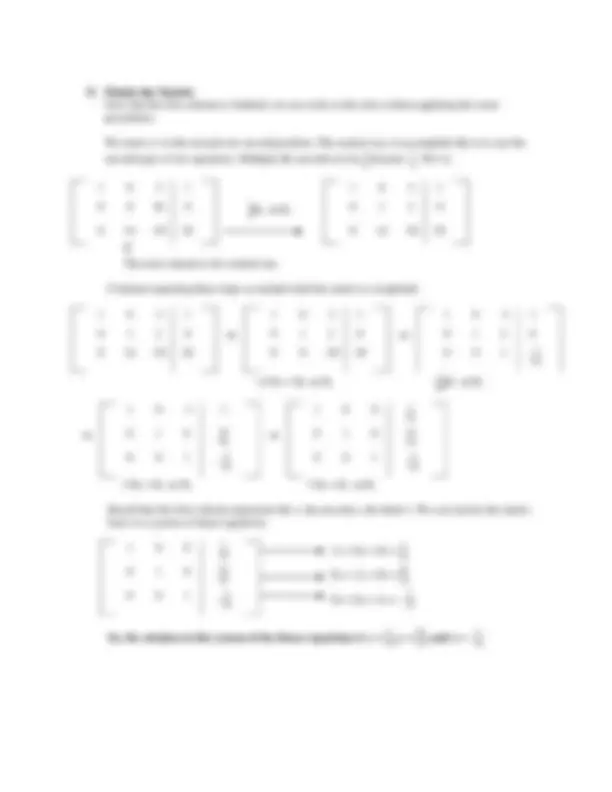



Study with the several resources on Docsity

Earn points by helping other students or get them with a premium plan


Prepare for your exams
Study with the several resources on Docsity

Earn points to download
Earn points by helping other students or get them with a premium plan
Community
Ask the community for help and clear up your study doubts
Discover the best universities in your country according to Docsity users
Free resources
Download our free guides on studying techniques, anxiety management strategies, and thesis advice from Docsity tutors
How to use elementary row operations to transform a matrix into reduced row echelon form, allowing the solution of a system of linear equations. Interchanging rows, multiplying a row by a constant, and adding a multiple of one row to another. A step-by-step example is provided.
Typology: Exercises
1 / 3

This page cannot be seen from the preview
Don't miss anything!


A matrix is a rectangular array of numbers - in other words, numbers grouped into rows and columns. We use matrices to represent and solve systems of linear equations. For example, the system of equations
8y + 16z = 0 *Make sure to line up all variables and x - 3z = 1 leave space if one is missing. -4x + 14y + 2z = 6
can be represented by what is called an augmented matrix as seen below:
Row 1 (R 1 ) → 0 8 16 0 Row 2 (R 2 ) → 1 0 -3 1
Row 3 (R 3 ) → -4 14 2 6
↑ ↑ ↑ ↑ x y z constant
Coefficients of the three unknown variables ( x, y, and z ) and the constant terms are placed in their respective places in the matrix.
Solving a system of equations using a matrix means using row operations to get the matrix into the form called reduced row echelon form like the example below:
1 0 0 3 0 1 0 6 0 0 1 2
This column can have any numbers.
We can perform elementary row operations on a matrix to solve the system of linear equations it represents. There are three types of row operations.
switched. 0 8 16 0 1 0 -3 1 1 0 -3 1 R 1 ↔ R 2 0 8 16 0 -4 14 2 6 -4 14 2 6
We can multiply any row by any number except 0. When a row is multiplied by a number, every element in that row must be multiplied by the same number. Below, R 2 is multiplied by 2.
We may also multiple a row by any number except 0 and add the results to another row.
Here, we multiplied R 1 by 4 and added the answer to R 3 to get a new row R 3.
4 R 1 = 4 0 -12 4
1 0 -3 1 1 0 -3 1 (^0 8 16 0) 4 R 1 + R 3 R 3 0 8 16 0
-4 14 2 6 0 14 -10 10
Note: R 1 never changed. We only multiplied R 1 by 4 so that we could add the product to R 3. There was no intention of keeping the product as part of the new matrix.
We will use the original matrix presented in part A. Our goal is to get the matrix in the reduced row echelon form that we discussed previously. The first step in solving our matrix is to “work out” the first column. This means that the column must contain only one 1 and the rest 0’s before we can continue on to the next column.
The first step is to get the 1 in the desired location. In this case, the upper left corner. To make it easier on ourselves we first look to see if we can interchange rows so we will have a 1 in the first position. Since R 2 already has a 1 in the first position, we switch it with R 1 using the interchanging row operation.
0 8 16 0 1 0 -3 1 1 0 -3 (^1) R 1 R 2 0 8 16 0 -4 14 2 6 -4 14 2 6
Always start with this column.
We must fill the rest of the column with 0’s. Since R 2 already has a 0, nothing needs to be done. However, the – 4 in R 3 must be changed. (The work for this step was done in part 3 of section B.) We multiply R 1 by 4 and add the results to R 3 , giving us a new R 3.
Note: You always use the row with the 1 for the multiplication, and you multiply by the opposite of the number that you are changing to 0.